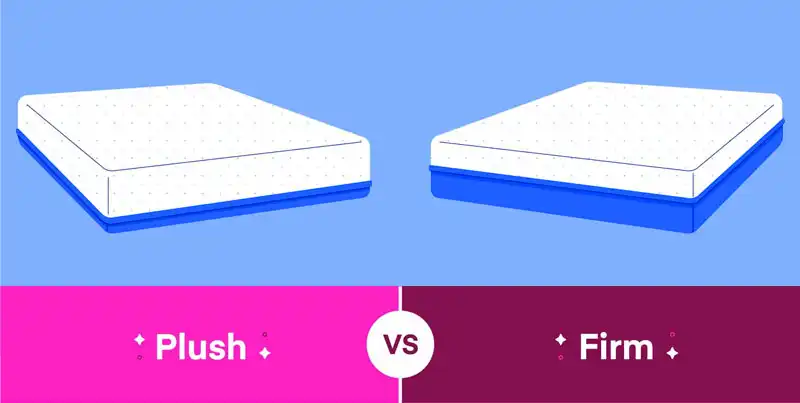When it comes to selecting your next mattress from the wide array of options available, making the right choice can be quite a challenge. As you embark on your search, one of the initial questions that probably comes to mind is, “Should I opt for a firm or soft mattress? Or perhaps something in between?”
What defines a plush mattress?
Plush mattresses possess a softer initial touch. However, the perception of “softness” can be subjective. What may feel comfortable and cushiony to one individual might not evoke the same sensation for someone else. This aspect becomes significant when you and your sleep partner have different reactions when testing out new beds. Additionally, it’s important to note that the ideal level of firmness for you hinges on various factors beyond mere feel, including body weight, joint health, and preferred sleep position.
A common misconception is that plush beds offer inadequate support, but this is far from the truth. They can indeed provide ample support, depending on the materials used and the design.
The comfort layer:
The top layer of a plush mattress, known as the comfort layer, is the softest section. This is where plush mattresses deliver their initial soft feel when pressure is applied. However, it’s worth noting that we don’t sleep on our hands. That’s why it’s crucial to lie down on the beds you’re considering. Spend a few minutes on each, assume your typical sleep position, and gauge your comfort. What may have seemed overly soft or excessively firm when touched by your hands might actually provide the comforting support you need for a restful sleep.
Seeking alignment:
Support is primarily provided by the layers beneath the top comfort layer, comprising denser, firmer materials such as foam, innersprings, or a combination of both. The purpose of these support layers is to ensure that your body maintains an optimal sleep position with your ears, shoulders, and hips properly aligned. How can you determine if your body isn’t aligned? Most likely, you’ll realize this while you sleep or upon waking up. Sleeping on a mattress that lacks sufficient support can be a painful experience, resulting in discomfort in your neck, shoulders, and/or back.
Adequate support and proper body alignment also contribute significantly to stress relief. When your body is correctly positioned on the mattress, relaxation comes more easily, and you benefit from increased oxygen intake, which improves circulation.
Remember: the comfort layer aids in falling asleep, while the support layer keeps you asleep.
Emphasizing sleep positions:
Your preferred sleep position—whether you sleep on your back, side, or stomach—is another crucial factor in choosing the right mattress. Side sleepers generally find plush mattresses most beneficial. These beds conform to the body’s contours and alleviate pressure on the shoulders and hips—two areas that tend to sink into the mattress.
Taking weight into account:
Your physical size also plays a role in mattress selection. Individuals with a lighter weight often prefer plush mattresses since they don’t sink too deeply into the comfort layer. Sleeping closer to the surface of the mattress makes it easier to change positions during the night as the body naturally adjusts.
Reducing disruptions:
Have you ever been awakened by your partner or pet when they get out of bed during the night? Or have you inadvertently disturbed your partner in the same manner? This is likely due to the movement being felt across the mattress. However, when a mattress, such as a plush one, has a sufficient comfort layer, it absorbs motion, allowing you to sleep undisturbed. This quality is referred to as “motion isolation.”
Pros and Cons of Plush Mattresses
Plush mattresses offer numerous advantages that make them an excellent choice for many sleepers. However, there are also some downsides to consider. Let’s examine both aspects.
Pros:
- Wide range of comfort levels available.
- Ideal for side sleepers as they provide pressure relief for shoulders and hips.
- Promote proper body alignment for optimal sleeping position.
- Deliver motion isolation, ensuring undisturbed sleep for you and your partner.
Cons
- Minimal support may lead to improper spine alignment.
- Potentially uncomfortable for individuals with back or joint pain.
- Lack of support for stomach sleepers.
- Sleeping deep in the mattress can trap body heat.
- Difficulty in changing sleep positions when the mattress is too soft.
- Who should use a plush mattress?
Plush mattresses are particularly suitable for lighter-weight individuals. Since they don’t sink as deeply into the comfort layer as heavier individuals, they can benefit from the support layer and achieve proper body alignment. Side sleepers also tend to benefit the most from the support, alignment, and pressure relief provided by plush mattresses. Additionally, if you experience shoulder and hip pain, a plush mattress can help alleviate discomfort.
Understanding Firm Mattresses
The primary advantage of a firm mattress is the support it offers. When lying on a firm bed, you’ll notice that you don’t sink into it as much as you would on a plush mattress. Depending on the level of firmness, you sleep on top of the mattress, and this makes it easier to change positions during the night. Firm mattresses also tend to sleep cooler since they don’t trap body heat.
However, the solid support of a firm mattress has its drawbacks, primarily related to pressure relief. Side sleepers may experience unwanted pressure on their shoulders and hips due to the lack of sinkage. On the other hand, back and stomach sleepers, who don’t want excessive sinkage, can benefit from a firm mattress to avoid lower back pain.
Understanding the Feel of a Firm Mattress
When pressing into a firmer mattress, you’ll notice that it doesn’t sink as far compared to a plush mattress. This is because firm beds have less cushioning at the surface. Typically, a firm mattress has 1 to 2 inches of comfort material at the top, whereas a plush mattress may have 4 inches or more. For sleepers who have difficulty moving, a firm mattress allows for freer movement during sleep and makes it easier to get in and out of bed.
The Importance of Support
Different levels of firm support in a mattress help maintain proper body alignment while sleeping on the surface. However, this surface sleeping can create issues for side sleepers who require some sinkage in their shoulders and hips to achieve optimal alignment. On the other hand, back and stomach sleepers can benefit from firm support.
Consideration for Heavier Individuals
Larger-framed and heavier individuals typically sleep better on a firmer mattress. This is because they don’t sink as deeply into the mattress compared to plush mattresses, which helps achieve better body alignment. By sleeping on or closer to the bed surface, heavier individuals experience cooler sleep, find it easier to change sleep positions, and are positioned effectively for rejuvenating sleep, particularly for stomach and back sleepers.
Pros and Cons of Firm Mattresses
Firm mattresses are a great choice for many sleepers. However, they may not be suitable for everyone. Let’s explore the pros and cons.
Pros:
- Proper body alignment for stomach and back sleepers.
- Easier breathing with increased oxygen intake.
- Additional comfort can be achieved by adding a mattress topper if needed.
- Mobility-challenged sleepers can move more easily.
Cons:
- Not the best choice for sleepers with muscle and joint pain.
- Some individuals may experience increased lower back pain without gentle support.
- Lighter weight sleepers may sleep on top of the bed without proper joint support.
- May require an adjustment period for sleepers not accustomed to firmer mattresses.
Who should use a firm mattress?
Consider the following guidelines to help determine if a firm mattress is suitable for you:
Larger-framed and heavier individuals can benefit from sleeping on a firm mattress as it helps maintain proper alignment of the shoulders and spine, promotes easier movement, and offers cooler sleep.
Most stomach and back sleepers can benefit from a firm mattress as it prevents excessive sinkage of the hips, allowing for proper alignment.
Individuals with joint pain can find comfort on a firmer bed as it reduces pressure on the circulatory system, making breathing easier and promoting deeper, more restful sleep.
Exploring Other Mattress Firmness Options
In addition to plush and firm mattresses, there are various options available on the firmness scale, ranging from extremely soft to extra firm. These include soft, medium, medium soft, medium firm, and firm mattresses. You’ll also come across different mattress designs, materials, and sleep experiences, such as gel foam, memory foam, innerspring, and hybrid mattresses, each catering to specific needs.
If you and your partner have different sleep needs, there are solutions available. Split King beds, which consist of two extra-long twin beds positioned together on a King base and frame, allow you to choose a bed with the right firmness for each of you. Additionally, adjustable bases offer individualized mattress and body position control, accommodating the unique needs of both partners.
Remember, with the wide range of mattress options, you can find the perfect solution that meets both your needs for a great night’s sleep. If you need further assistance, consider consulting a Mattress Firm Sleep Expert™, who can provide personalized guidance based on their extensive training and knowledge.
FAQs
Are firm beds uncomfortable?
Comfort is subjective, and what may be comfortable for one sleeper may not be for another. A firm mattress can be comfortable and supportive for heavier individuals, providing them with a great night’s sleep. Additionally, those who are accustomed to sleeping on a firm mattress or surface may find it comfortable.
Are plush beds bad for you?
The suitability of a plush bed depends on individual needs, sleep position, weight, and any physical discomfort that affects sleep quality. For lighter weight individuals, side sleepers, and those who require proper body alignment to alleviate pain or achieve optimal sleep, a plush bed can be a good choice. However, for heavier individuals who primarily sleep on their stomach or back, a plush bed may not be the best option.
Do firm mattresses last longer?
Firm mattresses often utilize durable materials such as coils, foam, and latex in their support layers. These materials are robust and well-made, ensuring that a firm mattress can provide years of quality sleep. Additionally, advancements in materials, construction techniques, and warranties from reputable manufacturers and retailers contribute to the longevity of firm mattresses.
Do hotels use plush or firm mattresses?
Most hotels typically offer medium to medium-firm mattresses for their guests. These types of beds are commonly preferred by customers due to their comfort and support, catering to a wide range of body types and sleep positions.
Is a firm or plush mattress better for your back?
When dealing with back issues, it is advisable to consult with a doctor or healthcare professional for personalized advice on mattress selection. However, as a general guideline, a medium-firm mattress can be a suitable choice for individuals experiencing back pain. This level of comfort and support helps contour to the body and maintain proper alignment during sleep.
Should my mattress be firm or plush?
The ideal mattress choice varies depending on individual preferences and needs, including those of your partner if applicable. The perfect mattress can be firm, plush, or somewhere in between.


